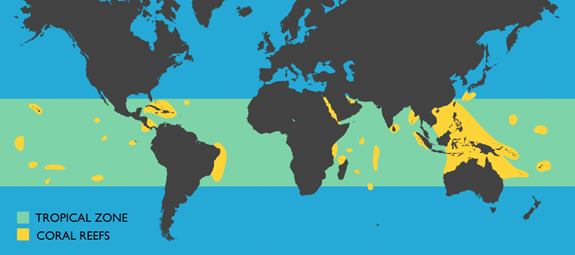CoralGeography: Difference between revisions
From coraldigest
No edit summary |
BrianNaess (talk | contribs) |
||
| Line 14: | Line 14: | ||
: 35-38 ppt<ref>Strykowski and Bonem, p. 36</ref> | : 35-38 ppt<ref>Strykowski and Bonem, p. 36</ref> | ||
;'''Turbidity''' | ;'''Turbidity''' | ||
: sediments causing high turbidity threaten coral survival by blocking sunlight and suffocating polyps. Corals prefer clear water.<ref>Strykowski and Bonem, p. 40</ref> | : sediments causing high turbidity threaten coral survival by blocking sunlight and suffocating polyps. Corals prefer clear water.<ref name="p40">Strykowski and Bonem, p. 40</ref> | ||
;'''Bottom Topography''' | ;'''Bottom Topography''' | ||
: corals need a hard, stable substrate to anchor to. Cyanobacteria (blue-green algae) must bind sediments in muddy or sandy bottoms to form a tough, leathery mat before coral can grow.<ref>Strykowski and Bonem, p. 40</ref> | : corals need a hard, stable substrate to anchor to. Cyanobacteria (blue-green algae) must bind sediments in muddy or sandy bottoms to form a tough, leathery mat before coral can grow.<ref name="p40">Strykowski and Bonem, p. 40</ref> | ||
==Coral Reef Distribution== | ==Coral Reef Distribution== | ||
Revision as of 13:11, 10 January 2013
Where are Coral Reefs Found?
Coral Reefs are typically found in a band stretching from 30° north to 30° south of the equator where the water temperature stays above 68°F year round. Because the coral relies on its photosynthesizing symbiote, zooanthellae, for food, growth occurs in areas of shallow depth and low turbidity where sunlight can reach the coral. Water movement is also important to the health of coral reefs. Tidal shifts and waves wash away waste and bring nutrients and oxygen to corals.[1]
Specific Environmental Conditions
- Temperature
- must remain between 68-83°F, but coral productivity is highest between 74-78°F.[2]
- Depth
- most commonly less than 30 ft, but can reach several hundred.[3]
- Emersion
- most corals will die if they are exposed to open air and sunlight, but some species may survive short periods of time out of the water during extremely low tides.[4]
- Salinity
- 35-38 ppt[5]
- Turbidity
- sediments causing high turbidity threaten coral survival by blocking sunlight and suffocating polyps. Corals prefer clear water.[6]
- Bottom Topography
- corals need a hard, stable substrate to anchor to. Cyanobacteria (blue-green algae) must bind sediments in muddy or sandy bottoms to form a tough, leathery mat before coral can grow.[6]
Coral Reef Distribution
Both the Caribbean and the Indo-Pacific have extensive regions meeting these conditions with flourishing coral reefs. The map below illustrates the current locations of reefs.
Notes
References
- Strykowski, Joe and Rena M. Bonem. Palaces Under the Sea. Crystal River, FL: Star Thrower Foundation, 1993, p. 31-43. Print.
